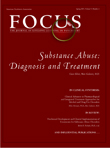Clinical Advances in Pharmacological and Integrated Treatment Approaches for Alcohol and Drug Use Disorders
Abstract
In this review, we highlight recent developments in the pharmacological treatment of alcohol and other substance use disorders and in programs designed for those with dual diagnosis disorders. The depot formulation of naltrexone, which recently received U.S. Food and Drug Administration approval, presents a more effective alternative to oral administration for alcohol dependence. Inconsistent support for the efficacy of acamprosate, however, underscores the need for more research concerning its optimal use. Recent testing of a depot naltrexone preparation for opioid-dependent patients shows promise for its clinical use. Buprenorphine represents a viable treatment option for opioid-dependent patients when combined with psychosocial modalities such as network therapy or contingency management. There has been an increase in the number of integrated programs for patients with a dual diagnosis, incorporating evidence-based psychosocial treatments combined with mutual self-help approaches, including 12-step-based and more global peer-led approaches.



